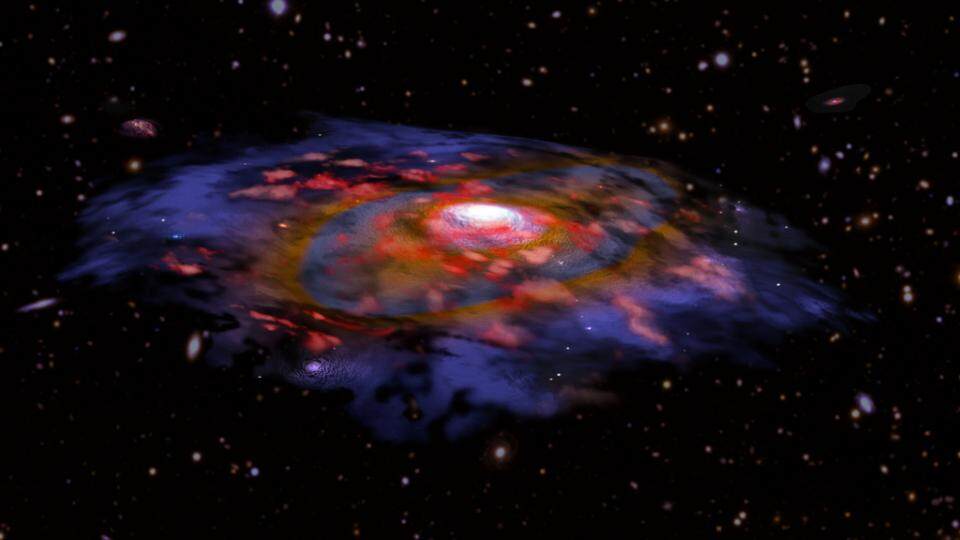By Andy Fell on October 27, 2020 in Science & Technology


Astronomers are getting a look at the dusty part of the distant universe with a huge field of telescopes in the high, dry Atacama desert of Chile. New results are telling us about the structure of the distant universe and yielding surprises about the evolution of galaxies.
The Atacama Large Millimeter/submillimeter Array, or ALMA, collects infrared light, so astronomers can learn more about distant galaxies as well as picking up objects that they could not see at all in the visible or ultraviolet spectrum.
“When light from young starts interacts with dust from dead stars, it shifts into the infrared,” said Brian Lemaux, an astronomer in the UC Davis Department of Physics and Astronomy. “There is a lot of information in that light.”
Lemaux is part of ALPINE, an international team of astronomers using ALMA to survey about 120 galaxies over 12 billion light years away. That means that they are looking back in time at these galaxies as they were 1 to 1.5 billion years after the Big Bang.
The target galaxies are already known from observations of their visible and ultraviolet light, Lemaux said, but the team can learn more about them from the ALMA observations. As a bonus, they can also see other objects at the same or similar distances that are dark in ultraviolet and visible light but shine brightly in the infrared.
Galaxies grow up faster than expected
Recent results from ALPINE, highlighted in eight articles released Oct. 27 in a special edition of the journal Astronomy & Astrophysics, show that these galaxies in the early universe were more mature than expected.
“We didn’t expect to see so much dust and heavy elements in these distant galaxies,” said Andreas Faisst of the California Institute of Technology. Dust and metals, the term that astronomers use for all elements besides hydrogen and helium, are considered to be byproducts of dying stars. But because these galaxies had not had much time to build stars, astronomers did not expect to see much dust or metals there. That dust is hiding a significant amount of ultraviolet light from newborn stars.
The galaxies were also considered to be relatively grown-up because they showed a diversity in their structures, including the first signs of rotationally supported disks — which may later lead to galaxies with a spiral structure, such as our Milky Way.
The team also observed that these early galaxies often crash into each other. Those collisions can induce rapid star formation or rip away gas that galaxies need to make stars, leaving a large shell of enriched gas. In some cases, the astronomers can see vast fountains of gas being stripped or shooting out of galaxies at hundreds of kilometers a second.
Lemaux and Professor Lori Lubin at the UC Davis Department of Physics and Astronomy, are also carrying out a survey known as C3VO of the large-scale environments of galaxies at this distance, using the W.M. Keck and Subaru telescopes on Mauna Kea. By looking at both regular galaxies from Keck and dusty infrared galaxies primarily from ALPINE, they hope to see the early stages of the formation of galaxy clusters.
“Before ALMA, we could see some especially bright infrared galaxies from single dish sub-millimeter telescopes, including those on Mauna Kea,” Lemaux said. “Now we are able to see more typical galaxies in the infrared, so we can track the evolution of these galaxies in dense environments more completely.”
ALMA is a partnership of the European Organization for Astronomical Research in the Southern Hemisphere, the U.S. National Science Foundation and the National Institutes of Natural Sciences of Japan in cooperation with the Republic of Chile. ALMA is funded by ESO on behalf of its member states; by NSF in cooperation with the National Research Council of Canada and the Ministry of Science and Technology; and by NINS in cooperation with the Academia Sinica, Taiwan, and the Korea Astronomy and Space Science Institute. Construction and operations are led by ESO; by the National Radio Astronomy Observatory, managed by Associated Universities Inc., on behalf of North America; and by the National Astronomical Observatory of Japan on behalf of East Asia. The Joint ALMA Observatory provides the unified leadership and management of the construction, commissioning and operation of ALMA.
All ALPINE papers are dedicated to the memory of Olivier Le Fèvre, principal investigator of ALPINE, who died in June.








































